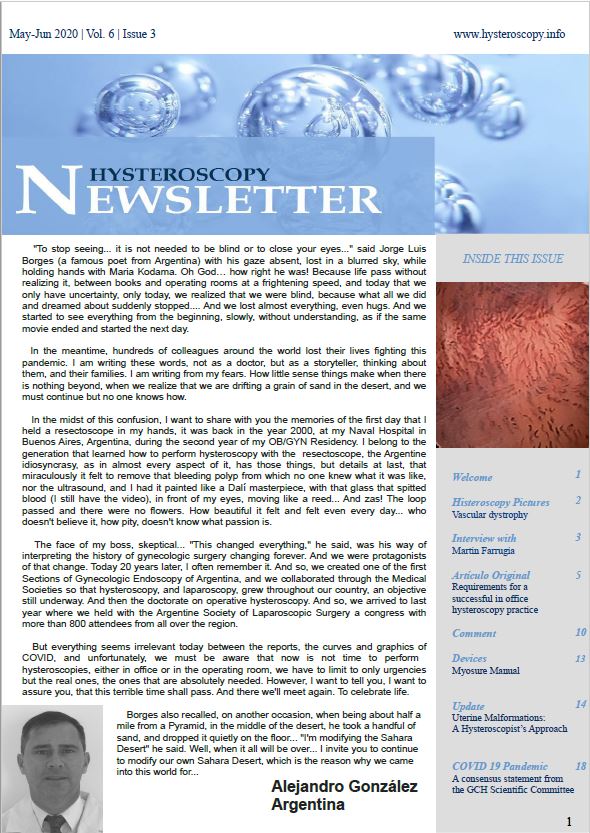
Hysteroscopy Newsletter Index.
Welcome
…But everything seems irrelevant today between the reports, the curves and graphics of COVID, and unfortunately, we must be aware that now is not time to perform hysteroscopies, either in office or in the operating room, we have to limit to only urgencies but the real ones, the ones that are absolutely needed http://www.hysteroscopy.info/index.php/2020/05/02/hysteroscopy-newsletter-vol-6-issue-3/
Interview with…
Martin Farrugia. Minimal Access Surgeon at East Kent Hospitals University NHS Foundation Trust
“Hysteroscopy is a useful diagnostic and therapeutic tool in gynecology and the way I see it, the main issue is under-utilization“
Requirements for a successful in office hysteroscopy practice
Currently entities such as the Royal College of Obstetrics and Gynecology (RCOG) or the International Society of Gynecologic Endoscopy (ISGE) have developed a ranking of hysteroscopic procedures, in terms of surgical complexity http://www.hysteroscopy.info/index.php/2020/05/02/hysteroscopy-newsletter-vol-6-issue-3/
Tubal or cervical ostium? The importance of making the difference in hysteroscopy
In the picture shared by Dr. Luis Alonso, gland openings are clearly identified in the form of white dots (white arrows) within pinkish mucosa (Fig5). Consequently, we can positively think, from this random shot, that the photographed mucosa around the ostium is neither an ecto nor an
endocervical tissue. It is an endometrium.
In figures 6-7, tubal polyps are examined from different angles. In all cases, the gland openings are present, thus indicating an ostium inside an
endometrial cavity. Moreover, a closer examination allows clear visualization of the circular muscle that defines the tubo-uterine sphincter. When contracted, this causes the ostial spasm described in hysterosalpingography.
Therefore, the answer to the test is: tubal polyps
Uterine Malformations: A Hysteroscopist’s Approach
Uterine malformations are not uncommon pathologies, with a prevalence of 5% in general female population and rises up to 16 % in women with fertility-related issues. http://www.hysteroscopy.info/index.php/2020/05/02/hysteroscopy-newsletter-vol-6-issue-3/
Impact on hysteroscopic procedures. A consensus statement from the GCH Scientific Committee
The COVID 19 pandemic has caused a global health emergency. Enforcing social distancing and preservation of hospital resources requires suspension of non-essential medical visits.
Procedures in which delay could potentially worsen the patient’s outcome, must be performed.
Adequate triage of patients with potential cancer conditions is critical to ensure patient safety during pandemic infections.
Theoretical risk of “viral” dissemination in the operating theater is higher during AGP than in hysteroscopy where the theoretical risk is extremely low, or negligible. Always favor the use of mechanical energy over thermal generating devices.
Also, when needed, use conscious sedation or regional anesthesia to avoid the risk of viral dissemination at the time of intubation/extubation.
Health care providers must comply with a step by step reimplementation of standard operating procedures, expediting the evaluation and management of all the deferred cases as soon as the benign pathology consultations can be safely restarted.
Patients with confirmed negative status for COVID-19 confirmed by PCR, requiring hysteroscopic procedures, should be treated using universal precautions.
www.hysteroscopynewsletter.com